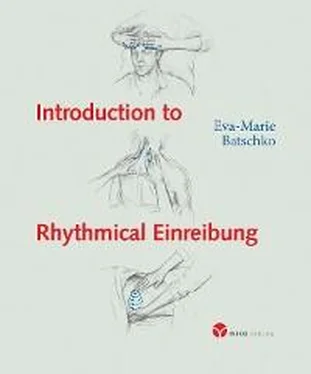In a next exercise, I slowly let my hands glide in a straight line over the surface of the water.
Here I can observe the flow and the formation of the vortex within the water. A more subtle feeling for this process of immersion is developed through regular practice.
The warmth exercise
I lift a hand to shoulder height, the palm of the hand facing forwards. I bend my fingers towards the heel of the hand without completely closing them in a fist.
I gradually perceive the warmth developing in the palm of my hand. It forms with ever greater clarity into a 'ball of warmth' with a 'boundary'. Now I open my hand again and slightly spread my fingers; as a result the ‘ball of warmth’ can expand and be ‘held’.
This exercise supports the warming of the hands before the Einreibung. Slightly spreading the fingers during treatment can preserve the warmth developed in this way. (If, on the other hand, the fingers were spread completely apart, the warmth would dissipate and coolness would surround my palm!)
The group warmth exercise (circle)
The participants stand in a circle and hold their left hand in the supination position (the ulna and the radius are in parallel), the right hand is in the pronation position.
Then they move their hands towards one another so that the circle is closed. The participants do not touch their neighbours’ hands directly but instead perceive only the warmth that arises between their hands.
This exercise requires attentiveness to the quality of the warmth: do the left and right hands show any differences in generating warmth?
What is the quality of the warmth arising in the space between the hands (e.g. radiating, rapidly developing or slowly building up)?
This exercise trains a sense of the warmth envelope created during the treatment.
The follow-up exercise
All the participants are moving about at the same time; therefore a lot of space must be available (possibly outdoors). The participants separate into pairs.
One participant in each pair goes ahead, thereby revealing their ’movement melody’. The other participant follows, trying to immerse themselves in the bearing of the leading participant’s movement (posture, movement approach, step length, etc.) and imitate it. As soon as the leading participant perceives that the following participant’s movements correspond to their own, they give the signal to change. Then the follower becomes the leader – and the exercise is repeated.
Subsequently, still in pairs, they discuss the types of movement of the leading participant (e.g., purposeful, soothing, tiring, refreshing, invigorating, energetic, powerful, etc.).
In the plenum, this is then put in the context of the three-fold human constitution and the question is considered as to whether the gait was respectively dominated by the head, metabolic and limb or rhythmical system; ’head-types’ are dominated by the nervous and sensory system and thus their gait reveals excessive control by the head; the movement flow is halting. If the metabolic and limb system dominates, the movement brimming with life starts in the hip area, sending impulses to the limbs – and sometimes the head also begins to ’dance’. When the movements are in harmony with the rhythmical system, a harmonious, light and graceful gait comes about, the source of which is initiated between the shoulder blades. This exercise trains the perception of the threefold nature of the human organism revealed in walking.
Independently of such exercises, we can also in our day-to-day lives try to sense the manifestation of the four constitutional elements of the human being in their handshake as we greet another person:
Physical body:
Findings – Form or deformation of the hand (large – small – narrow – wide – long – short, etc.)
Etheric body:
State – Condition of the hand (moist and warm – moist and cold – dry and hot – dry and cold –sticky with sweat – drops of sweat, etc.)
Astral body:
Mood – Psychological state revealed through the handshake (shy – cordial – limp – squeezing – powerful – gripping – listening – shaking – calm – assertive, etc.)
The I:
Presence – Revelation of the spirit through the handshake (presence of the distinctive personality – spiritual presence – authenticity – interest, etc.) Here eye contact is important as well!
Performing the treatment
1. The space
A quiet space (patient’s room or practice) without interference from radio, television, telephone, visits, visitors, etc. Ventilate well before treatment, but keep windows and doors closed during treatment (absolutely avoid draughts!).
Provide a pleasantly warm room temperature. Place the massage table or bed so that the patient is not exposed directly to the sun or to electric light sources (this also applies to the chair when seated).
The massage table should be accessible from at least three sides; all-round access is necessary in the case of whole-body and pentagram Einreibung.
The substances must be kept within easy reach.
2. The massage table, bed or chair (without armrests)
Soft underlay
Pillows of different sizes
Knee rolls
Sheets (brushed cotton)
Woollen blankets for covering the patient
Towels for covering the patient
Hot water bottles if preheating is needed
Possibly footstool or stool for seated treatments.
3. The patient
Meet with the patient to inform them about the place (e.g. patient’s room) and course of the Einreibung, the substances used and the necessary rest period after treatment.
The patient should keep a small booklet in which they describe their state (e.g. ‘pain’ – ‘pleasantly warm’ – ‘cool’ – ‘more mobile’ – ‘shivering’, etc.) before and during treatment, after the rest period and before going to sleep at night.
The practitioner should also documents their experiences and perceptions in a work report.
The indication must be checked with a doctor.
4. Positioning of the patient
The patient should be able to lie comfortably and relaxed.
Lying on the back:
A pillow so that the cervical spine relaxes.
A knee roll so that the stomach remains relaxed.
Possibly hip cushions on the sides in order to avoid outward rotation of the legs.
Lying on the abdomen:
A cushion under the abdomen so that the chest can lie without pressure.
Possibly two small cushions under the armpits to relax the shoulders and the neck.
A knee roll under the feet to avoid too much stress on the ankles.
Sitting position:
A cushion on the thighs, so that the neck and upper arms are relaxed.
A pillow under the soles (or a footrest) if the feet do not touch the floor.
5. Covering the patient:
The whole body of the patient is wrapped in a brushed cotton sheet and covered with a woollen blanket (of sufficient size!).
The part of the body to receive treatment is wrapped in a towel and only uncovered during the treatment.
A pre-heated brushed cotton sheet is required for the whole-body Einreibung (use oven or hot water bottles).
6. Direct preparation of the practitioner
Before starting, picture the course of the treatment (sequence of Einreibungen) inwardly such that flowing transitions can arise (parts leading to a whole) – consciously shape the beginning and the end (e.g. ‘end legs downwards with foot Einreibung’ – or; ‘begin legs upwards with foot Einreibung’).
Calm covering up and uncovering are essential parts of the treatment!
Take off any jewelry or watches before treatment!
Wash your hands before each treatment!
The oil is poured into the cupped left hand immediately before the Einreibung.
The bottle is closed again with the right hand (essential oils evaporate easily!).
Читать дальше



![Andrew Radford - Linguistics An Introduction [Second Edition]](/books/397851/andrew-radford-linguistics-an-introduction-second-thumb.webp)








